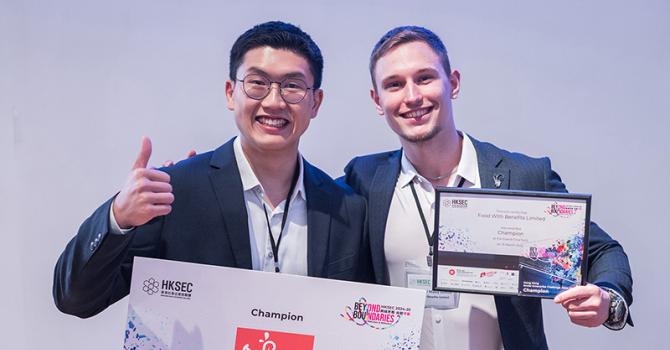The “Design Come True” Experience of Developing Antimicrobial Hand Cream
Andy Choy Man-Hin, Isaac Kwan Chi-Shing, and Michael Lui Wing-Piu (all undergraduate Class of 2020 in the Department of Chemical and Biological Engineering) came up with the idea of creating a long-lasting antimicrobial hand cream in the Product and Process Design course in Spring 2020. With the tremendous support from Prof. Marshal Liu and alumna-entrepreneur Ms. Vanessa Ho Po-Ki, the idea came to fruition and the product was successfully commercialized. Andy shares how the team went through this challenging yet fruitful “design come true” experience, which became one of his favourite learning experiences at HKUST.
I was born and grew up in Hong Kong. As a teenager, I was passionate about the latest technology and always hoped to make something real in the future. Therefore, without any hesitation, I joined the School of Engineering at HKUST after my secondary school study. Since I was more interested in chemicals and bioproducts, I chose the Chemical and Biomolecular Engineering major, with a minor in Bioengineering. The curriculum equipped me with the knowledge of designing and operating a chemical, physical, or biological process to convert raw materials to high-value products (e.g. drugs and fuel oil), with the consideration of safety, economics, and sustainability. These products involve large-scale production in chemical plants, and I wonder whether these techniques can be applied to consumer products, which play increasingly indispensable roles in our lives.
Fortunately, in the Spring term of 2020, my last term at HKUST, an elective course CENG 4150 Product and Process Design, taught by Prof. Marshal LIU, was offered and I immediately enrolled. I was never disappointed by the content and especially amazed by the course project. The group project required the application of theories and tools learned from the course in the design of a real product, ideally with a prototype. I partnered with Isaac KWAN Chi-Shing and Michael LUI Wing-Piu, and very soon, we came up with an idea of making an antimicrobial healthcare product. Due to the COVID-19 pandemic this year, health is the primary concern and many people worry about being infected. So they keep using alcohol rubbing gel whenever they touch anything. However, alcohol is not benign to our skin, and moisture loss on our hands may cause contact dermatitis. During the discussion with my teammates, we decided to make a hand cream with a long-lasting antimicrobial effect. This product aims not only to kill microbes, and maintain the aseptic environment on the surface of our hands for hours, but also to protect our skin from water loss and allergy.
Under Marshal’s guidance, my teammates and I collaborated on the conceptual design, investigated and selected the active ingredients which can work synergistically to kill microbes and virus, formulated the composition with ideal Hydrophilic-Lipophilic Balance value to stay on the skin, and explored the manufacturing process, the business plan and economic analysis. The weekly progress meetings with Marshal pushed us to follow the project schedule and eventually, we were able to build our product from scratch. Marshal also encouraged us to join a local innovation competition to explore entrepreneurship. However, without experiment testing and prototype as a result of lab work suspension due to the coronavirus, we did not have much luck in getting any awards in the contest.
I ended up in this course with an impressive project and an outstanding grade. After that, I struggled with the step forward. How to make the prototype and test its effectiveness and safeness? It should be a promising product to serve people, but will anyone be interested in investing in a student-initiated idea? Just at that time, Marshal messaged me that one entrepreneur and alumna, Ms. Vanessa HO Po-Ki (1998 BEng in Chemical Engineering), showed great interest in this product. It was an unexpected and invaluable chance for us, and we immediately discussed with Vanessa on the feasibility and subsequent work.
To commercialize the product, we know that product safety comes first – the product must meet safety requirements or regulations for cosmetics. We double-checked different countries’ regulations and laws to make the necessary adjustment to the prototype product. To test the long-lasting antimicrobial effect, we contacted different testing labs. However, such effectiveness test was not available in most of the testing labs in Hong Kong. It meant that we had to perform the experiment by ourselves. Luckily, the Department of Chemical and Biological Engineering has always been very supportive of students’ experiential learning, and it generously provided lab space, equipment and consumables. Marshal and technicians also instructed the experiment design, conduction, and data analysis. Within a month’s hard work, we successfully proved that the antimicrobial effect could last more than two hours on the skin, which was consistent with the design and model. Now, the first batch of products – 10,000 bottles – are ready for sales. We are still optimizing the products for effectiveness and performance, and hopefully there will be an updated formula soon.
For now, I am confident to say that this project is one of my favourite learning experiences at HKUST. During these months, I have been managing the project as efficient as possible. Setting up deadlines for every step of progress, from the product conceptual design, formulation, to experiment testing and manufacturing, and making sure that no time was wasted. We are very thankful for the tremendous support from our department, especially the enthusiastic encouragement from Marshal and the unlimited trust and assistance from Vanessa. They helped a lot in building up the product design and manufacturing the hand cream, as well as solving various real problems about marketing, testing, and commercializing. Though it was an intense and challenging summer, it has proved to be a fruitful and extraordinary experience for me. I hope I will have another chance to go through this “design come true” experience in the future.
Related link:
- SENG news (Oct 23, 2020): Chemical and Biological Engineering Alumna, Students and Faculty Join Hands in Product Commercialization






